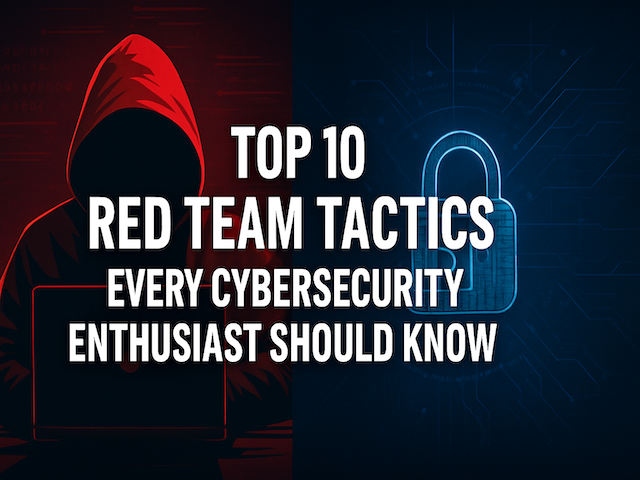Top 10 Red Team Tactics Every Cybersecurity Enthusiast Should Know

There are two primary teams discussed in simulations and exercises: Blue Teams and Red Teams. While Blue Teams work on defending systems and reacting to attacks, Red Teams are similar to ethical hackers who mimic actual attacks to test the defenses.
Red Team operations are essential in discovering vulnerabilities in a company's security stance before actual attackers do. But what do Red Teams actually do? Let's delve into the most prevalent techniques they employ – broken down in an easy-to-understand manner.
Prefer watching instead of reading? Here’s a quick video guide
Reconnaissance (Information Gathering)
Red Teamers begin by conducting recon – like a spy would. Their aim is to gather as much intel as they can about the target without raising suspicion.
Passive Reconnaissance:
- Public databases such as LinkedIn, Twitter, and company websites are searched for data.
- Applications such as Shodan (to identify exposed devices), Google Dorking, and whois are employed.
- They search for emails, technologies employed (such as web servers), and known vulnerabilities.
Active Reconnaissance:
- Consists of directly engaging with the target – for instance, pinging servers or port scanning.
- Applications such as Nmap are employed to identify open ports and services that can be used.
Consider it like burglars breaking into a home – searching for open doors or windows.
Social Engineering
Why hack systems when you can hack humans? Red Teamers frequently mimic phishing attempts to see how well staff handles suspicious emails. Typical tactics are:
- Phishing Emails: Phony emails that trick users into clicking on harmful links or opening infected attachments.
- Pretexting: Impersonating someone the user trusts (such as IT support) in order to acquire sensitive information.
- USB Drops: Placing infected USB drives in public areas in hopes someone inserts them.
If one employee gets caught, it can provide attackers with an entry point.
Initial Access (Getting In)
After they've gathered enough intel and perhaps duped someone, Red Teams attempt to establish initial access.
Here's how:
- Exploiting Vulnerabilities: Taking advantage of known flaws in software (such as old web servers or poor VPNs).
- Brute Force Attacks: Guessing lots of passwords until one succeeds.
- Credential Stuffing: Logging in with leaked passwords from another site (because so many use the same passwords everywhere).
The objective is to gain a beachhead within the target network.
Privilege Escalation
Getting in is only the beginning. Most accounts lack sufficient access to actually cause harm. Red Teamers seek to become admins so they can manipulate additional systems.
They may:
- Exploit misconfigurations (e.g., services running with excessive permissions).
- Search for saved passwords in memory or configuration files.
- Abuse vulnerabilities in the operating system.
One clever method is token impersonation, where attackers “borrow” the privileges of a more powerful user without their knowledge.
Persistence
Imagine breaking into a house – you’d want a way to come back later, right? Same with Red Teamers. They set up persistence mechanisms so they can access the system again, even if the original flaw is patched.
Techniques are:
- Backdoors: Hidden entry points into the system, commonly masquerading as normal files or processes.
- Scheduled Tasks or Scripts: Code running at a given time automatically.
- Startup Modifications: Programs running each time the computer starts.
Lateral Movement
After getting inside one system, Red Teams do not relent. They continue sideways to other computers in the network – similar to jumping from one room in a building to another.
They employ tools such as:
- PsExec or WMI: To remotely manage other computers.
- Pass-the-Hash: Utilizing stolen password hashes (as opposed to actual passwords) for login.
- Remote Desktop Protocol (RDP): If open, this grants full desktop access.
Their endgame is to locate valuable systems – such as databases, email servers, or domain controllers.
Command and Control (C2)
Red Teamers require a means of communication with the compromised systems.
They establish Command and Control (C2) channels, which allow them to issue commands and obtain information without detection.
Techniques are:
- Using encrypted channels to prevent detection by security software.
- Covering in normal traffic, such as spoofing web or DNS requests.
C2 is such as the radio between thieves and their getaway driver – quiet, quick, and concealed.
Data Exfiltration
After finding useful information (such as customer accounts or internal memos), Red Teams mimic stealing them to assess just how quickly one can.
- Data exfiltration is what this exercise accomplishes through:
- Compression and encryption to bypass detection.
- Outputting data little by little (trickling it) not to generate notices.
- Leveraging cloud utilities (such as Dropbox or Google Drive) to subtly smuggle information out of sight.
Sometimes, they'll even stage a ransomware attack where files get encrypted and a phony ransom note is left behind.
Covering Tracks
A good Red Team doesn't leave footprints. To keep Blue Teams from finding out, they:
- Delete records of their activity.
- Utilize stealthy tools that are indistinguishable from normal processes.
- Spoof IP addresses or utilize proxies to conceal their origin.
This makes it more difficult for defenders to determine what occurred or where the attack originated.
Reporting and Debriefing
This is the critical portion. Red Teamers are lawful hackers, after all, so they capture all details – what they did, how they did it, and how the defenders reacted.
They write a comprehensive report that covers:
- A timeline of events.
- Screenshots or evidence of exploitation.
- Recommendations for remediation.
Then they sit down with the Blue Team and stakeholders to talk about improvements.
Final Thoughts
Red Teaming isn’t about showing off – it’s about helping organizations find and fix weaknesses before real attackers do. The tactics used are realistic, stealthy, and strategic, just like those of cybercriminals.
If you’re interested in cybersecurity, learning Red Team tactics is a great way to understand how attackers think – and how to stop them.




